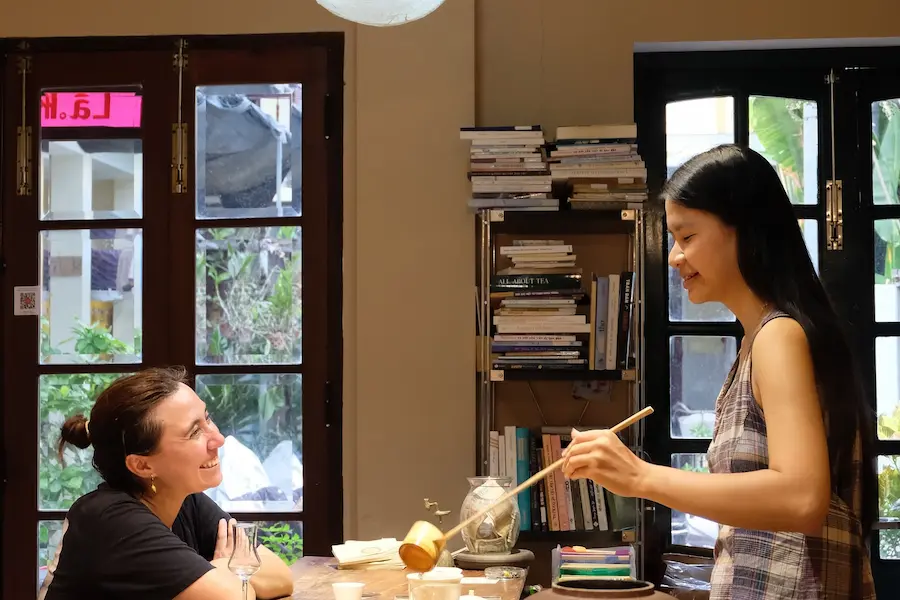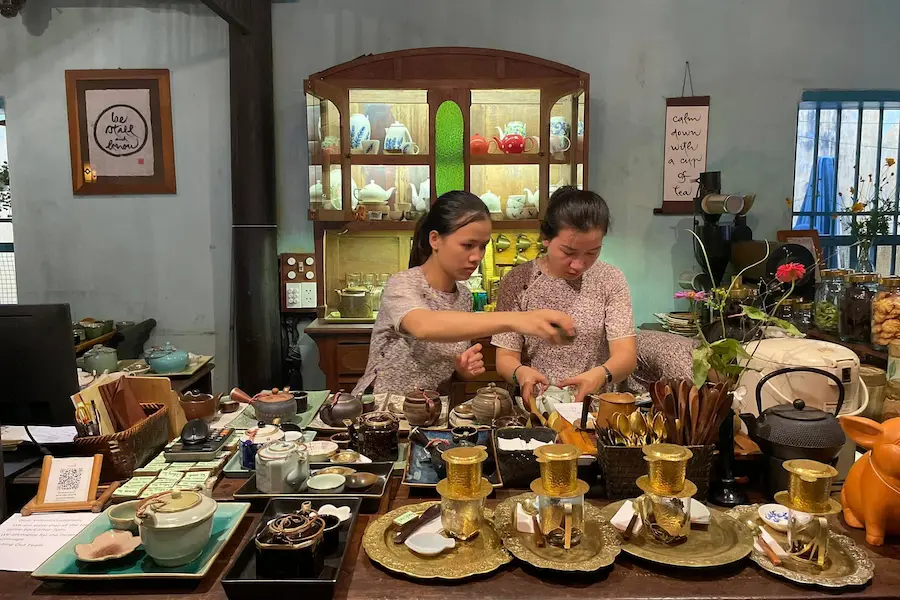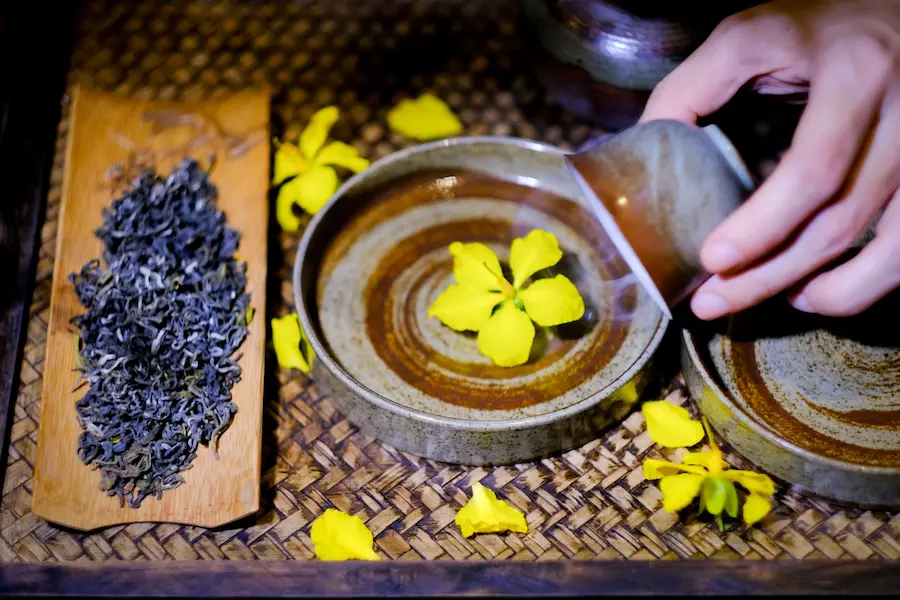In Vietnam, tea is more than just a drink – it’s a ritual of calm, a meditation, and a philosophy of living. The art of tea meditation, known locally as thien tra, invites you to slow down, breathe deeply, and find stillness in every sip. Far from the noise of daily life, this centuries-old practice opens a window into Vietnam’s spiritual heart, where nature and mindfulness quietly meet.
What Is Tea Meditation?
Tea meditation has its roots in Zen Buddhism and focuses on mindfulness through the act of preparing and drinking tea. Every small movement – boiling, pouring, sipping – is done with awareness and gratitude.
In Vietnamese tradition, tea meditation is about reflection and simplicity, not performance or luxury. It’s the harmony between person, tea, and the moment itself. Even the smallest sounds – the whisper of water, the clink of porcelain – become part of the meditative rhythm.
The Roots of Tea Meditation in Vietnam
Vietnam’s tea heritage stretches back centuries, shaped by Chinese philosophy and local spiritual beliefs. In the past, monks and scholars gathered over tea as a way to reflect, share wisdom, and connect with the universe.
Over generations, this evolved into thien tra – a ritual that weaves mindfulness, hospitality, and reverence for nature into one experience. Today, in pagodas across Vietnam, monks still hold silent tea gatherings after morning prayers, each cup a path to compassion and clarity.
Tea also symbolizes balance in Vietnamese culture – between hot and cold, bitter and sweet, body and spirit. Whether it’s poured in a humble countryside home or a quiet Hanoi teahouse, it always whispers the same reminder: live slowly, live mindfully.
The Spiritual Meaning Behind Every Cup
Tea meditation is less about drinking tea and more about being fully present. Participants are encouraged to listen – to the bubbling of water, the rising aroma, the taste that lingers gently on the tongue.
It’s not about judging the tea’s quality but sensing its presence – the warmth of the cup, the breath between sips, the silence between thoughts. This quiet awareness mirrors Buddhist mindfulness, helping practitioners anchor themselves in the present.
Where to Experience Tea Meditation in Vietnam
1. La.Kao Tea House, Hoi An
Hoi An’s La.Kao Tea House perfectly blends Vietnamese tea craftsmanship with modern mindfulness. The minimalist, tranquil setting allows visitors to focus on the sensory beauty of tea meditation in Vietnam - from the earthy aroma of wild tea leaves to the precise rhythm of pouring and tasting.
Here, the experience feels both local and universal. It’s not just about tea; it’s about slowing down and reconnecting with the art of presence. Many travelers describe it as a peaceful, grounding escape in the heart of the old town.

2. Reaching Out Tea House, Hoi An
Just a short stroll from Hoi An’s lantern-lit streets, Reaching Out Tea House adds a deeper, social dimension to mindfulness. Run by hearing-impaired staff, the teahouse turns silence into a shared language. Every interaction happens through handwritten notes and quiet gestures - creating a rare, thoughtful atmosphere.
Their “tea meditation for beginners” sessions encourage guests to savor every sensation: the texture of the cup, the soft scent of local teas, the gentle pour of water. It’s a space where silence isn’t empty - it’s full of meaning. For travelers seeking both cultural immersion and social impact, this is one stop that truly stays with you.

3. Hien Tra Nhi Do Mai, Hue
In Hue, where tradition and artistry run deep, Hien Tra Nhi Do Mai celebrates the timeless craft of flower-scented teas. Known for lotus-infused blends and other locally harvested varieties, this teahouse is less about showmanship and more about preserving heritage.
Visitors can sit in its peaceful courtyard, surrounded by greenery and the scent of fresh blossoms, learning about how local families handcraft their teas. Drinking slowly here feels like joining a centuries-old story of patience and respect for nature. For anyone on a cultural or wellness journey through Central Vietnam, this stop captures the region’s gentle, reflective spirit.

4. Hidden Attic Tearoom, Ho Chi Minh City
Amid the urban rush of Ho Chi Minh City, the Hidden Attic Tearoom offers a moment of stillness. Tucked inside a vintage apartment, it’s a small, intimate space where tea ceremonies are paired with short guided meditations.
Guests are guided through tea history, brewing techniques, and mindful tasting - turning an ordinary afternoon into a personal retreat. For those with limited time in the city, it’s a simple yet enriching way to pause and recharge before heading back into the vibrant chaos of Saigon’s streets.

The Commercial Potential of Tea Meditation
For travel planners, tea meditation in Vietnam offers real versatility. It can be framed as a 90-minute luxury urban session or a half-day village experience with visits to tea gardens.
Wellness groups see it as a mental reset; cultural travelers view it as a deep dive into Vietnamese traditions. Either way, it connects stories, senses, and stillness – a winning trio for immersive tourism.
How to Choose the Right Tea Meditation Experience
Decide first what you want – depth or simplicity. Workshops in Hue or Hoi An offer immersive storytelling and cultural learning; urban teahouses focus on refinement and ease.
Check for English-speaking facilitators and the right ambiance – garden, pagoda, or traditional home – as each setting shapes the mood. Silent spaces like Reaching Out create serenity; modern salons in Saigon add polish and accessibility.
Adding Tea Meditation to Your Vietnam Tour Packages
For travel designers, tea meditation is an elegant addition to your itinerary. Position it as a “mindful pause” within broader journeys focused on culture or wellbeing. For corporate groups, frame it as a reflective leadership exercise.
To market effectively, pair evocative images – steam rising from a pot, candlelit cups – with short video clips. Authentic atmosphere sells better than overused buzzwords. Explore more itinerary ideas with Vietnam vacation packages.
Practical Tips for Booking Tea Meditation Sessions
Reserve in advance – popular places like La.Kao and Reaching Out fill up quickly. Some venues only host small groups or private sessions. Include exact timing in itineraries to maintain the sense of calm.
For richer experiences, pair tea meditation with temple visits, traditional lunches, or handicraft workshops – creating a balanced, story-driven travel day.
A Personal Reflection on Tea Meditation
Personally, every tea meditation session reminded me that the smallest rituals hold the deepest meaning. When practiced with intention, even lifting a cup becomes transformative. The best moments aren’t about photos; they’re about feeling the stillness between breaths. Leaving Hoi An, I carried that silence like a souvenir – invisible, but grounding.
Recommended Tea Meditation Venues in Vietnam
La.Kao Teahouse (Hoi An) – minimalist, modern, deeply mindful
Reaching Out (Hoi An) – ethical and beautifully silent
Hien Tra Nhi Do Mai (Hue) – heritage tea traditions preserved
Hidden Attic (Ho Chi Minh City) – urban calm with vintage charm
Each can stand alone or be integrated into customized tours. To design them smoothly, connect with Vietnam local tour operators who already partner with these venues.
Why Tea Meditation Matters for Travelers and Tour Operators
Ultimately, tea meditation in Vietnam isn’t just another activity – it’s a meaningful layer of the country’s culture. It delivers calm travelers, glowing reviews, and a unique product story. Tell it authentically, set expectations clearly, and let the ritual speak – one quiet sip at a time.


